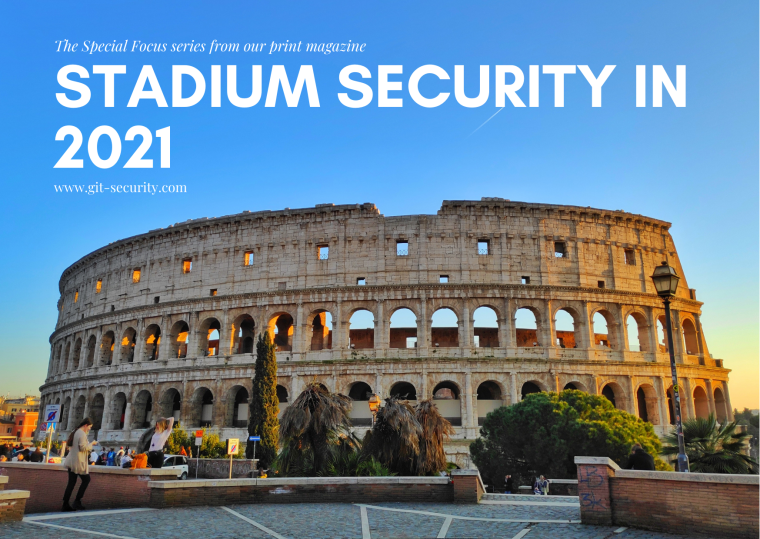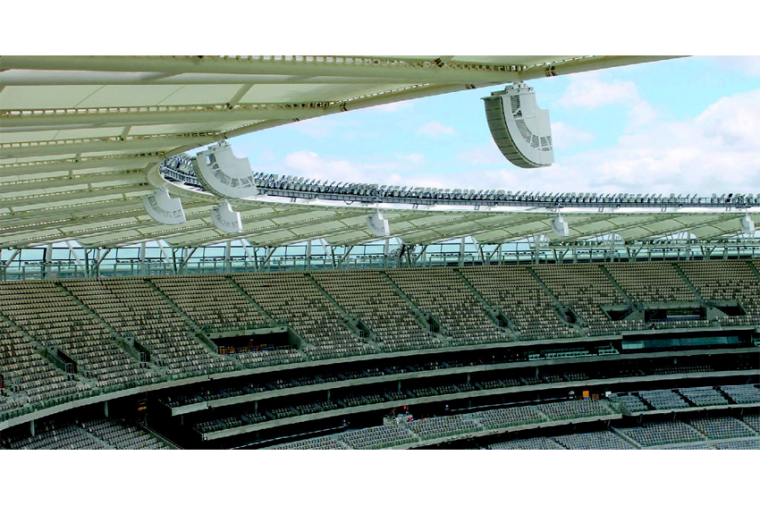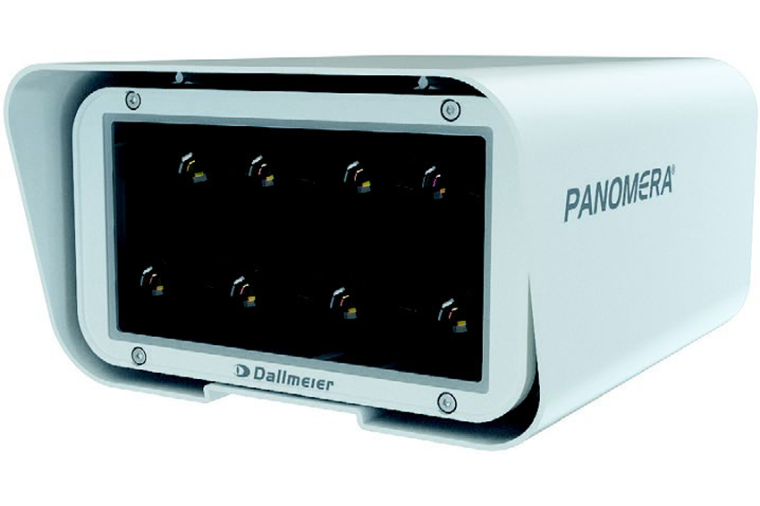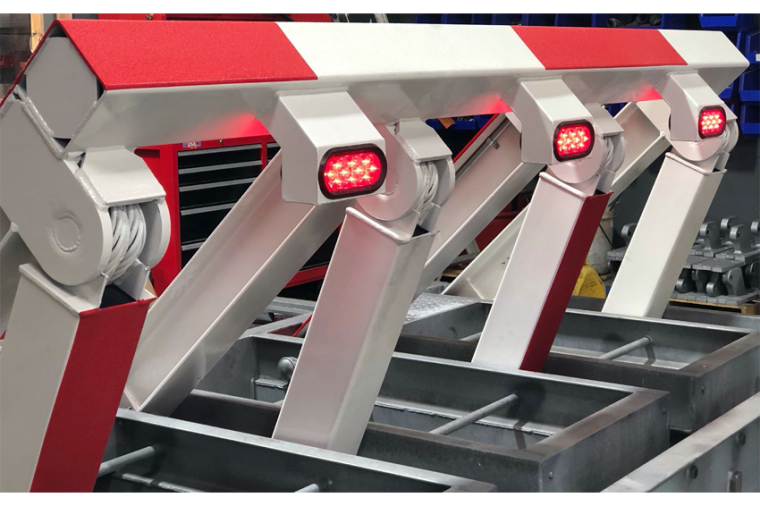Special Focus: Stadium Security in 2021
We have been holding sports events for thousands of years, where dozens of competitors and thousands of spectators come together to race chariots or formula one cars, to throw spears or javelins, to wrestle or see who can run the fastest, to play some ball game like rugby, hockey, baseball, tennis or soccer, or even to hear some musicians at work. You would think that by now we would have safety and security at such events under control. Well, by and large, we have, but improvement is always possible. GIT SECURITY looks at some of the security products and solutions specifically conceived for stadiums, and others that add a lot to overall safety and security.





Whether a stadium is old, new, or even just about to be constructed, a great deal of thought must go into the safety and security of everyone who is going to attend events there. To quote Lewis Carroll, we should “begin at the beginning, and go on till you come to the end: then stop.” So where is the beginning? Let’s, first of all, consider the most numerous group of people, the spectators.
Access Control – The Way in
To prevent those getting into the stadium who are only intent on causing trouble of one kind or another, we need a type of access control. In its simplest form, this can be the ticket – paper or digital – purchased in advance and checked at the gate. This process though is slow and requires a lot of personnel to operate. A quicker solution is provided by Flowte, who can provide a complete stadium access and ticketing management solution. Laser barcode and QR code scanners are quick, flexible and efficient in controlling the validity of tickets, either in paper form or as images on mobile devices. They integrate with turnstiles from various manufacturers. You might also make contact with SecuTix who have adapted their ticketing solution to be able to observe the applicable social distancing regulations for that particular venue. StadiumGuard from Biosec offers a modular solution that includes biometric identification options to create a zero-tolerance security system, which ensures that banned ‘fans’ really are kept out.
The ticket purchase process may already allow some pre-selection of preferred spectators by using the data that process generates to flag up any known troublemakers, criminals or indeed terrorists. Even so, weapons may be brought into the stadium by previously inconspicuous spectators. Evolv Technology has developed a solution aided by artificial intelligence that helps to detect a wide range of concealed firearms, metallic weapons and improvised explosive devices carried by a visitor entering a premises. The ‘hands-off’ solution is quicker than pat-downs by security personnel, will detect different types of threat more reliably and has the additional advantage that pockets and bags do not have to be emptied. With many years of experience in people and object screening, Smiths Detection have a complete palette of detection products capable of sniffing out trouble before it gets any further.
Vehicular Access
Controlling which vehicles have access to the ‘inner sanctum’ of a stadium can be, at least partially, automated these days. As well as the traditional portable medium such as a magnetic stripe card or an RF token that is presented to a reader at the vehicle entrance, there are also automated barriers operated by radio signals, by recognition of a symbol in the windshield, and also by the analysis of the registration plate of frequently visiting vehicles. This latter version has the advantage of being almost a free add-on with today’s video systems (see below). They are looking anyway at such entrances and exits and a simple plug-in to that system will provide reliable plate recognition to automatically grant access to authorized vehicles without further human intervention. They interact with pole barriers, electric gates or buried road blockers, or bollards such as those provided by ATG Access. The Wedge road vehicle blocker from Gibraltar may also be of interest to you.
Security Video Surveillance
Let us move on to an old favorite of security personnel. Camera manufacturers have been working together with stadium operators and security forces around the world for many years to provide high definition images of individual members of the public amongst the crowd - let’s call them ‘fans’, even though that is sometimes not what they claim to be. The results are impressive and, coupled with today’s intelligent video analysis techniques, it is relatively easy to have an alert raised quickly when known troublemakers are spotted within the stadium by automatic and continuously running face recognition. Of course, local laws on privacy may have an influence on the extent to which surveillance of individuals may be used, but generally there is no political objection to fishing out those who are only there to cause trouble. You will find systems from, amongst others, Dallmeier who provide their well-known Panomera camera in stadium environments. This delivers not only wide-angle views but also high-definition zoomed images of individual spectators, and both from the same multi-focal camera unit. To control all video operations and be able to rapidly respond to emerging security situations via a single, modular platform, Genetec offers their Omnicast solution. Plug-in video analytics modules can transform the data arriving from the cameras into actions and enhance overall security.
Health Video Surveillance
Facial recognition is widespread these days and used for various purposes. An important ‘spin-off’ capability of this is, unfortunately, temperature checks of people entering a facility. One of many systems on the market is facial recognition and thermal imaging technology from Purview which analyzes people as they file into a stadium. The system checks and gives access to one of two routes – one leads straight in for those with no alerts and, if a raised temperature is detected, the other leads to a quarantine area where stadium officials can take further action.
Audio Alerting
In an emergency, concise and clear instructions on what action to take will help to minimize the negative effects of whatever event is occurring. The only way to communicate to a crowd of people is audibly, and a stadium’s loudspeaker system must therefore be carefully configured to cope first of all with the noise created by thousands of people and secondly with the very strange acoustics of the different shapes and sizes of stadiums. Powersoft can provide a Dante-enabled system, tailored with clever software control, to the individual characteristics of any particular stadium, no matter whether under an open sky or a closed roof. Detailed consultation will also be undertaken by Nexo in the planning stage to ensure that their public address/voice alerting system fulfils and, probably, even exceeds your expectations of clearly audible stadium sound.
Valuables Storage
Going below the rows of spectators above, our second group of people at stadiums are the players, artistes, hospitality staff, team coaches and officials who are busy with the sporting event or concert upstairs, while their personal belongings are often kept in lockers in rooms within the depths of the building below the seating. The amount spent will to some extent dictate how effective these lockers are against theft taking place when the locker rooms are deserted. Sadly, many simple lockers can be opened in seconds with a simple crowbar bought from any hardware shop. There are alternatives, such as those from the wide range produced by C+P Möbelsysteme in Breidenbach, Germany, while the basquill locks fitted by Rosstec to their lockers will frustrate any would-be thief.
Fire Detection
There have been some tragic examples of inadequate fire detection within stadiums in the past. Thankfully, hardly any stadiums still in use are built of wood as they used to be. Nevertheless, there are still potentially flammable materials and risk areas in any stadium today, such as in the often large kitchen areas and an up-to-date fire detection system therefore belongs at the top of the list of essential equipment. Addressable detectors pinpoint and smoke or gas accumulation, which is shown on the schematic map of the complex. Using optical flame and open path gas detection, the significant offshore experience of Spectrex in the oil and gas industry and their specialist detectors is also beneficial for a stadium environment. Esser Systems provide turnkey fire/gas detection systems built on their spectrum of flexible components, which includes rate-of-rise and flame detectors as well as aspirating smoke detectors.
Lightning Protection
Carrying on back up into the fresh air, many stadiums have open roofs with no opportunity to close them. This poses a deadly risk for players and spectators if a storm develops nearby. Some parts of the world have more frequent electric storms than others, but the risk of a lightning strike is everywhere, and they are nearly always unexpected. But the TWX300 thunderstorm warning system from Vaisala can provide early indication that trouble is brewing by detecting static charge, which gives time to retreat under cover to safety. The system can trigger lights, sirens or other devices when there is potential for lightning strikes. Biral, who also make systems for the aviation industry, offer the BTD-200 system to give advance warning of thunderstorm threats. CRS in Wisconsin have put all their significant experience into their Strike Guard lightning warning system. This provides various levels of alarm of an approaching lightning threat.
The Holistic Approach
If Aristotle was right, then Armored Things’ approach to management will make the whole stadium more than the sum of its parts. Their software takes input from both new and existing systems and combines predictive physical security analytics with real-time data to minimize risks. Among other aspects, the package provides Covid-related access management and crowd intelligence results as well as enabling better space utilization. The Singapore-based ESS Group also look at the whole task ahead of each event and provide comprehensive security personnel and services through their worldwide network of highly-trained resources.
For the stadium management, safety and security can sometimes – erroneously – be viewed as a necessary expense without a return. In fact, some of the systems and services mentioned above deliver valuable data about the people that visit their stadium, their preferences and habits. From that one can deduce where there is opportunity for change and/or improvement and, ultimately, higher revenue. So, for now at least and until the next review, we have reached the end. Thank you Lewis.
Companies mentioned
Armored Things – www.armoredthings.com
ATG Access – www.atgaccess.com
Biosec – www.biosecgroup.com
Biral Lightning Protection – www.biral.com
CRS Lightning Warning – www.crs4rec.com
C+P Möbelsysteme – www.cp.de
Dallmeier Cameras – www.dallmeier.com
ESS Group – www.ess.com.sg
Esser Systems – www.esser-systems.com
Evolv Technology – www.evolvtechnology.com
Flowte – www.flowtesport.com
Genetec – www.genetec.com
Gibraltar – www.gibraltarus.com
Nexo – www.nexo-sa.com
Powersoft – www.powersoft.com
Rosstec – www.ross-tec.de
SecuTix – www.secutix.com
Smiths Detection – www.smithsdetection.com
Spectrex – www.spectrex.net
Vaisala Thunderstorm Warning – www.vaisala.com
Business Partner
Genetec2280 Alfred-Nobel Blvd.
H4S 2A4 Montreal
Canada
most read

Is Your Venue Ready for Martyn’s Law?
Martyn’s Law demands stronger security by 2027. Is your venue prepared to protect and respond?

Assa Abloy's battery-powered Aperio KL100 secures lockers
Boost workplace security and operational flexibility by securing more than just doors.


When the Internet stumbles: Why DNS is important
When DNS fails, the internet stumbles-AWS outage proves resilience and redundancy are vital for digital trust

What Does Ethical AI Governance Look Like in Practice?
The InCyber Briefing will explore AI, post-quantum readiness, data sovereignty, and crisis simulation






